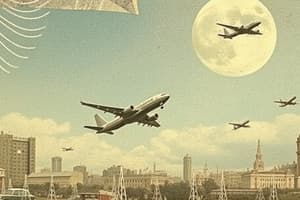Podcast
Questions and Answers
Which organization represents the majority of the world's airlines?
Which organization represents the majority of the world's airlines?
- EASA
- ICAO
- FAA
- IATA (correct)
Cabin crew members are primarily responsible for safety regulations only.
Cabin crew members are primarily responsible for safety regulations only.
False (B)
What are Dangerous Goods in the context of air travel?
What are Dangerous Goods in the context of air travel?
Substances that pose risks to health, safety, property, or the environment.
IATA trains more than ________ aviation professionals each year.
IATA trains more than ________ aviation professionals each year.
Match the module with its focus:
Match the module with its focus:
Which of the following topics is included in the IATA Position Papers?
Which of the following topics is included in the IATA Position Papers?
IATA has specifically mentioned that they hold liability for errors in the publication.
IATA has specifically mentioned that they hold liability for errors in the publication.
What is the purpose of the COVID Reporting Process for Member Airlines launched by IATA?
What is the purpose of the COVID Reporting Process for Member Airlines launched by IATA?
The IATA provides guidance for managing aircraft airworthiness during and post __________.
The IATA provides guidance for managing aircraft airworthiness during and post __________.
Match the following IATA initiatives with their descriptions:
Match the following IATA initiatives with their descriptions:
Flashcards
IATA Position Papers on COVID-19
IATA Position Papers on COVID-19
Documents released by IATA addressing public health concerns during the COVID-19 pandemic during air travel. They focus on temperature screening, passenger health data, and harmonization of health declaration forms.
IATA Safety and Flight Operations Guidance
IATA Safety and Flight Operations Guidance
Guidelines provided by IATA to airlines involving managing aircraft airworthiness during and after the COVID-19 pandemic.
IATA COVID Reporting Process
IATA COVID Reporting Process
A system developed by IATA for member airlines to report operational concerns related to COVID-19.
Pressurized Cabins in Aviation
Pressurized Cabins in Aviation
Signup and view all the flashcards
The Boeing 787 Dreamliner
The Boeing 787 Dreamliner
Signup and view all the flashcards
Aviation's Carbon Emission Reduction Target
Aviation's Carbon Emission Reduction Target
Signup and view all the flashcards
CORSIA (Carbon Offsetting and Reduction Scheme for International Aviation)
CORSIA (Carbon Offsetting and Reduction Scheme for International Aviation)
Signup and view all the flashcards
Early Stages of Aviation
Early Stages of Aviation
Signup and view all the flashcards
Fuel Efficiency
Fuel Efficiency
Signup and view all the flashcards
Evolution of the Airline Industry
Evolution of the Airline Industry
Signup and view all the flashcards
Study Notes
IATA Position Papers
- IATA has issued position papers on temperature screening, collection of self-declared passenger health data, and harmonization of health declaration forms/data sets.
- These position papers aim to address public health concerns related to air travel during the COVID-19 pandemic.
Other Guidance Materials
- IATA has provided safety and flight operations guidance, including managing aircraft airworthiness during and post-pandemic.
- IATA has also developed a COVID reporting process for its member airlines to address operational concerns.
Customer Vouchers Initiatives
- IATA has established a repository for airline voucher and ticket exchange policies.
IATA Training
- IATA offers training courses for aviation professionals around the world.
- More than 1,000,000 students have completed IATA training, with 100,000+ trained annually.
- The training focuses on safety, security, and sustainability in the industry.
Evolution of the Airline Industry
- The world's first airline was Deutsche Luftschiffahrts-Aktiengesellschaft, founded in 1909 in Germany.
- Early flights were primarily sightseeing tours.
- The introduction of pressurized cabins in aircraft like the Boeing 307 Stratoliner, allowed for higher and faster flights.
- The "De Havilland" Comet, the first commercial jet airliner, was introduced in 1952 but was grounded due to safety concerns.
- The TU-104, a Russian jet airliner, became the first successful jet airliner in service between 1956 and 1958.
Fuel Efficiency and Environmental Concerns
- The Boeing 787 Dreamliner is known for its fuel efficiency, using 20% less fuel than similarly sized aircraft.
- The Boeing 747-8 Intercontinental boasts a 15% reduction in carbon emissions and a 30% smaller noise footprint.
- Major aircraft manufacturers, like Airbus and Boeing, prioritize fuel efficiency and carbon emission reduction.
Aviation’s Carbon Emission Reduction Target
- The aviation industry aims to reduce its net carbon emissions by 50% by 2050 compared to 2005 levels.
- This goal is being achieved through technology improvements, operational improvements, infrastructure upgrades, and market-based schemes like CORSIA.
- CORSIA, a carbon offsetting and reduction scheme for international aviation, was adopted by ICAO in 2016.
Evolution of the Airline Industry as a Global Industry
- The global airline industry has evolved significantly since its early stages.
- Early flights were mostly sightseeing tours.
- The advent of pressurized cabins revolutionized air travel.
- Jetliners have become the mainstay of modern air travel.
- The industry continues to focus on technological advancements, fuel efficiency, and environmental sustainability.
Studying That Suits You
Use AI to generate personalized quizzes and flashcards to suit your learning preferences.
Related Documents
Description
Explore the key initiatives and guidelines set by IATA in response to the COVID-19 pandemic, focusing on passenger health, safety, and operational adjustments. Additionally, learn about IATA's extensive training programs aimed at enhancing industry standards among aviation professionals.




